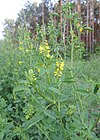Note: This is a project under development. The articles on this wiki are just being initiated and broadly incomplete. You can Help creating new pages.
Difference between revisions of "Melilotus officinalis"
| Line 36: | Line 36: | ||
==Identification== | ==Identification== | ||
===Leaf=== | ===Leaf=== | ||
| − | {{Leaf|Simple|alternate|}}<ref name="Leaf"/> | + | {{Leaf|Simple|alternate|Trifoliate with petioles up to 1 in. (2.5 cm) long. Leaflets are greyish green, 1 in. (2.5 cm) long and 0.3 in. (0.85 cm) wide, dentate, and oblong to ovate.}}<ref name="Leaf"/> |
===Flower=== | ===Flower=== | ||
| − | {{Flower| | + | {{Flower||2-6 in. (5.1-15.2 cm) long|Yellow|5|Flowers are small, floppy, tubular at base becoming broader toward outer edges, 0.3 in. (0.85 cm) long with 5 petals. Blooming occurs from summer through fall.}} |
===Fruit=== | ===Fruit=== | ||
| − | {{Fruit|Simple Fruit|| | + | {{Fruit|Simple Fruit||Seed pods are smooth or slightly reticulated, 0.3 in. (0.85 cm) long, terminates in a beak, and contains 1 or 2 seeds|}} |
===Other features=== | ===Other features=== | ||
| Line 53: | Line 53: | ||
==How to plant/cultivate== | ==How to plant/cultivate== | ||
| − | + | Melilotus alba is an annual to biennial herb that can grow from 3-8 ft. (0.9-2.4 m) tall. | |
<ref name="How to plant/cultivate"/> | <ref name="How to plant/cultivate"/> | ||
==Commonly seen growing in areas== | ==Commonly seen growing in areas== | ||
| − | {{Commonly seen|Lowland forest | + | {{Commonly seen|Lowland forest}}. |
==Photo Gallery== | ==Photo Gallery== | ||
| Line 72: | Line 72: | ||
<ref name="chemical composition">[https://www.researchgate.net/publication/289192804_Chemical_constituents_from_Melilotus_officinalis#:~:text=Results%20Twelve%20compounds%20were%20obtained,)%2C%20robinin%20(8)%20clovin Chemical composition]</ref> | <ref name="chemical composition">[https://www.researchgate.net/publication/289192804_Chemical_constituents_from_Melilotus_officinalis#:~:text=Results%20Twelve%20compounds%20were%20obtained,)%2C%20robinin%20(8)%20clovin Chemical composition]</ref> | ||
| − | <ref name="Leaf">[ | + | <ref name="Leaf">[https://wiki.bugwood.org/Melilotus_officinalis Morphology]</ref> |
| − | <ref name="How to plant/cultivate">[ | + | <ref name="How to plant/cultivate">[https://wiki.bugwood.org/Melilotus_officinalis Cultivation Details]</ref> |
</references> | </references> | ||
==External Links== | ==External Links== | ||
| − | * [ | + | * [https://wiki.bugwood.org/Melilotus_officinalis Melilotus officinalis] |
[[Category:Herbs]] | [[Category:Herbs]] | ||
Latest revision as of 14:50, 3 June 2020
Melilotus officinalis, known as yellow sweet clover, yellow melilot, ribbed melilot and common melilot, is a species of legume native to Eurasia and introduced in North America, Africa, and Australia.
Contents
- 1 Uses
- 2 Parts Used
- 3 Chemical Composition
- 4 Common names
- 5 Properties
- 6 Habit
- 7 Identification
- 8 List of Ayurvedic medicine in which the herb is used
- 9 Where to get the saplings
- 10 Mode of Propagation
- 11 How to plant/cultivate
- 12 Commonly seen growing in areas
- 13 Photo Gallery
- 14 References
- 15 External Links
Uses
Poor blood circulation, Leg pain and heaviness, Night cramps, Itchiness, Fluid retention.
Parts Used
Chemical Composition
Twelve compounds were obtained from the 70% ethanol extract of M officinalis and their structures were identified as β-sitosterol, coumarin, methyl 3-(4-hydroxyphenyl)propionate, kaempferol-3-O-α-L-rhamnoside, rutin, apigenin-7-O-β-D-lutinoside, dibutyl phthalate, robinin, clovin, kaempferol-3-O-rutinoside, isoquerecitrin, and medicarpin 3-O-β-glucopyranoside. [1]
Common names
| Language | Common name |
|---|---|
| Kannada | |
| Hindi | |
| Malayalam | |
| Tamil | |
| Telugu | |
| Marathi | NA |
| Gujarathi | NA |
| Punjabi | NA |
| Kashmiri | NA |
| Sanskrit | |
| English | yellow sweet clover, yellow melilot, ribbed melilot, common melilot, |
Properties
Reference: Dravya - Substance, Rasa - Taste, Guna - Qualities, Veerya - Potency, Vipaka - Post-digesion effect, Karma - Pharmacological activity, Prabhava - Therepeutics.
Dravya
Rasa
Guna
Veerya
Vipaka
Karma
Prabhava
Habit
Identification
Leaf
| Kind | Shape | Feature |
|---|---|---|
| Simple | alternate | Trifoliate with petioles up to 1 in. (2.5 cm) long. Leaflets are greyish green, 1 in. (2.5 cm) long and 0.3 in. (0.85 cm) wide, dentate, and oblong to ovate. |
Flower
| Type | Size | Color and composition | Stamen | More information |
|---|---|---|---|---|
| 2-6 in. (5.1-15.2 cm) long | Yellow | 5 | Flowers are small, floppy, tubular at base becoming broader toward outer edges, 0.3 in. (0.85 cm) long with 5 petals. Blooming occurs from summer through fall. |
Fruit
| Type | Size | Mass | Appearance | Seeds | More information |
|---|---|---|---|---|---|
| Simple Fruit | Seed pods are smooth or slightly reticulated, 0.3 in. (0.85 cm) long, terminates in a beak, and contains 1 or 2 seeds | {{{5}}} | {{{6}}} |
Other features
List of Ayurvedic medicine in which the herb is used
Where to get the saplings
Mode of Propagation
How to plant/cultivate
Melilotus alba is an annual to biennial herb that can grow from 3-8 ft. (0.9-2.4 m) tall. [3]
Commonly seen growing in areas
Photo Gallery
References
External Links
- Ayurvedic Herbs known to be helpful to treat Poor blood circulation
- Ayurvedic Herbs known to be helpful to treat Leg pain and heaviness
- Ayurvedic Herbs known to be helpful to treat Night cramps
- Ayurvedic Herbs known to be helpful to treat Itchiness
- Ayurvedic Herbs known to be helpful to treat Fluid retention
- Herbs with Sweet clover used in medicine
- Herbs with common name in English
- Habit - Herbs
- Index of Plants which can be propagated by Seeds
- Herbs that are commonly seen in the region of Lowland forest
- Herbs




